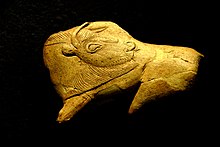Bison Licking Insect Bite is a prehistoric carving from the Upper Paleolithic, found at Abri de la Madeleine near Tursac in Dordogne, France, the type-site of the Magdalenian culture, which produced many fine small carvings in antler or bone.
| Bison Licking Insect Bite | |
|---|---|
 | |
| Material | Reindeer antler |
| Width | 10.5 cm |
| Created | c.15,000 years before present |
| Discovered | Tursac, Dordogne, France |
| Present location | Les Eyzies, Dordogne, France |
Created sometime between 20,000 and 12,000 BP (15,000 BP according to the museum), it was formerly in the Musee des Antiquites Nationales, St. Germain-en-Laye, but has been transferred to the expanded National Museum of Prehistory in Les Eyzies-de-Tayac-Sireuil that opened in 2004, not far from its findspot. It is a carved and engraved fragment of a spear-thrower made of reindeer antler. It depicts the 10.5 cm figure of a bison, of the now extinct species steppe wisent (Bison priscus) with its head turned around and showing its tongue extended. It is thought the spear-thrower was broken into roughly its present shape before the carving was made from the fragment, hence the need to show the turned-back head of the animal in order to fit the existing structure.[1]
See also
editReferences
edit- ^ "Collections", National Museum of Prehistory Archived 2015-04-30 at the Wayback Machine in Les Eyzies-de-Tayac-Sireuil (in French)
External links
edit